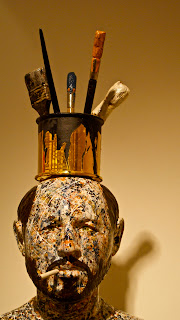The Italians have a saying, dalle stelle alle stalle, "from the stars to the stalls, roughly equivalent to "Pride comes before a fall." Add this to the common knowledge that journalists (at least the real ones) work too hard but are often compensated with fabulous perks in order to get the idea of photographer Carly's and my experience at the Florence Antiques Biennial, our first outing after the County Fair (Ruralia, see preceding post) in the Cascine Park.
As the name implies, this world-renowned show-- the oldest of its kind in Italy— offers visitors the opportunity to view and perhaps purchase rare works created by prestigious artists that are destined to become part of private and public collections. Our first stop on during this Cinderella day was the press conference, held at the Villa Cora hotel (see July's post "Poolside Cocktail Hour" to get a good look at where we were invited guests).
Not bad, huh? But let's not forget that we were there for work. Besides the Beautiful Florence blog, an article on the Antiques Show was published by my company, Magenta, in Vista, Florence & Tuscany, the area's only magazine in English. We joined our colleagues in the lobby to sign in for the press conference.
Once inside, the Biennial's president, Giovanni Pratesi, told us that Italian antique dealers dominate the show—only 14 of the 88 exhibitors come from foreign countries. On display until October 9 are an astonishing number of artworks--2700 in all--ranging from paintings, sculptures, furniture, porcelain and textiles to represent various time periods and artistic styles. The oldest exhibits date before Christ, with the bulk falling somewhere in the 17th, 18th and 19th centuries. As we were to notice, there was also a scattering of outstanding modern and contemporary works--you could actually take home a Mirò if you happen to have enough change in your pocket.
The conversation on the Antiques Biennial continued over a complementary lunch (this is Italy after all).
While Giovanni Pratesi (pictured right) was waiting for the next course to arrive, he confided to journalists that, because of the recession, the antiques market for buyers has never been better thanks to many cash-hungry art patrons who are sacrificing a jewel or two of their collections. He also praised the work of a commission of experts who certified each antique's authenticity, removing any piece of dubious make or origin. Exportation of antiques is also a problem--the best case scenario is a 40-day wait, but in the case of a sale at Florence's Antiques Show, the permit is granted in only two days! Carly and I were the only foreign press members present--our Italian colleagues did not bat an eyelash. In Italy, it is all a matter of who you know... After lunch, the hotel provided shuttle service to the Antiques Biennial venue, Palazzo Corsini.
Again, not bad, huh? Palazzo Corsini is located in downtown Florence (riverside address: Lungarno Corsini). The Corsini family rent it out to the Antiques Show every two years. Each section of the Biennial is planned by set designer Pier Luigi Pizzi to complement the existing frescoes and baroque decorations characteristic of Palazzo Corsini.
After showing my press pass (they even checked the photo), Carly and I spent nearly two hours on the ground floor where we visited the 40 stands located there. At stand #1, Robilant, we immediately noticed a beautiful antique painting, "A View of the Arno and Ponte Santa Trinita in Florence" by local expatriate artist Thomas Patch (Exeter 1725 - Florence 1782).
Moving on, we arrived at a stand (to remain nameless) right at the moment when an antique dealer opened a secret door to show some hidden treasure (we think) to a prospective client.
When we asked the dealer what was it was, he closed the door and told us to come back in a half hour. Mum's the word.
I don't know which stand we saw this work and who the sculptor happened to be, but if this hunk of a man happened to be alive, he would be date material. Oh, I think I found the reference in my Beautiful Florence journal--he must be the Lute Player (from where and when I don't know).
Next, we saw two dancing Moors, 18th century works from Germany. It is easy to imagine that the sculptures might have served as inspiration for Josephine Baker in her choice of costume for the Paris stage.
At the Sperone & Westwood (New York) stand, Carly especially liked this contemporary exhibit by Luigi Ontani (1997).
Nearby was a beautiful stand featuring antique jewelry. The exhibits were so attractive--see for yourself
-- that I forgot to take notes.
-- that I forgot to take notes.
A sensation of awe came from turning the corner to come upon this statue fragment from 480 B.C. at the Turchi stand, exhibited by the only antique dealer in Italy specializing in archeological works.
If it weren't for prospective thieves and the price tag, it would look nice in the garden...
Actually, the only price tags we saw displayed were at stand # 39, Les Enluminures, which specializes in illuminated manuscripts. A single page started at 25,000 euro.
Actually, the only price tags we saw displayed were at stand # 39, Les Enluminures, which specializes in illuminated manuscripts. A single page started at 25,000 euro.
A fabulous gift would be these antique table and chairs on view at the Diana Vreeland stand.
But keeping in mind that we are heading towards Christmas, perhaps giving (or receiving) an authentic 18th century Neapolitan nativity scene would be more apropos.
Referring back to the previous post, "A County Fair in Florence," the mother has been found but now the child is missing. Where is Gesu Bambino (baby Jesus)?
















No comments:
Post a Comment